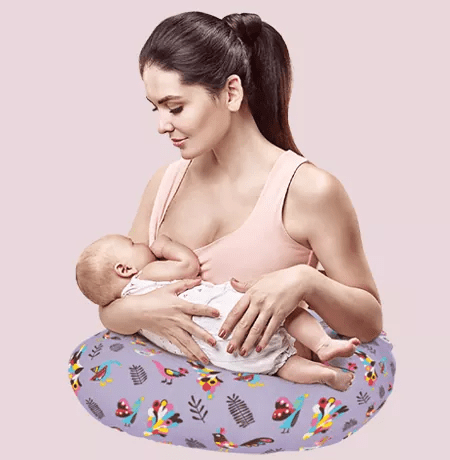We’re happy about being new parents, exuberant about bringing a life to the world, and cheerful about constantly having a mini version of ourselves at home. We get so excited that some of us even over prepare ourselves – buy toys, clothes, milk bottles, baby and mother diapers, cot, and whatnot! The one thing that we forget, though, is the fact of having to feed the baby as soon as they sway out of the womb. Some of us do plan it, but most of us skip it like we skip our periods. We must remember that it is as natural as it is, and yet as technical as it could be.
Latching
Latching is not tricky per se, but it can be somewhat difficult in the first few times you nurse your newborn.
All you need to do is grasp your breasts and place your thumb a little above the areola and the fingers below it, and move the nipple around your baby’s mouth until they open and start to suck. Also, ensure that the areola is also inside the mouth, instead of only the nipple.
Proper latching would be evident when you see your little one’s long yet slow jaw, temple, or ear movements. You’ll get used to doing it within just two-three times that you do it.
Techniques for Comfortable Breastfeeding
If you really think it through, it just happens. The moment you push your baby out of your body (or it is taken out), you will be able to feel the yearning for them. The nurse will give you the baby to hold to your chest, and then a series of events will follow, eventually leading to your little one sucking milk out of you.
It won’t be so difficult with nurses and your family around you for help, however, when you go back home, on your own, with not many mom-experts to help you, that is when you’ll know how much you needed this guide.
Read on.
The Cradle Hold
The first, classic picture that comes to our heads of breastfeeding is holding the baby in our arms while sitting comfortably with a straight back. The baby’s tummy touches ours and the baby calmly feeds. This position or technique is the Cradle Hold Technique. For better comfort, if your baby feeds from the right breast, hold your baby primarily with the right forearm, supported by the left; likewise for the left.
Side-lying Technique
This technique is ideal and practical for night feeds or for women who can’t sit for longer or have had a cesarean and/or stitches. You simply lie down on your side and the baby either lies on their back or side and feeds.
The Crossover-cradle Hold Technique
If your baby has trouble latching on, this technique may be better for you than the normal cradle technique. Very much similar to cradle style but you switch your arms with respect to the breast, so there’s a crossover between you and the baby. The baby feeding from the left lies carefully and cozily clung in your right forearm, easily latching on and supported by the left arm.
Laid-back Position for C-section Moms
Breastfeeding in other positions is often difficult for C-section moms as they involve the baby resting on the stomach. The laid-back position allows you to lie on your back and let the baby rest on your shoulder and feed, not exerting any pressure on the stitches.
The Rugby Hold Technique
Sit comfortably in your bed and hold your baby tucked under your arm like a rugby ball – this arm will be the same side that the baby’s nursing from. You can support the back of the baby with the forearm and hold them face-up with the lips reaching the nipples easily. Hold your breast with your opposite arm and allow the baby to take it in.
This position can be used by moms with twins, one in each hand, have large breasts or flat nipples, or those who have had C-sections.
Upright Breastfeeding Technique
This is another position or technique that has to do with sitting. Sit on a chair or a bench and allow the infant to sit or straddle on your thighs so they face up and feed.
This position is much better for babies suffering from reflux or ear infections, older babies who can support themselves, or very young infants with proper anchorage and support. It also works fine with babies with tongue-tie.
Reclining Position Technique
This is a relatively comfortable position that allows you to lie in bed and nurse. You will need to cradle the baby and support them in your arms, while also aligning your back and hips in one straight line (so it doesn’t give you a backache). Hold the baby close to your chest and let them feed. If it makes the process better, you can put some blankets or pillows below the baby to keep them high enough to feed without, again, getting some pain in the arms.
Additional Tips
Since most of your time will go nursing, you have to make some arrangements to make the process comfortable. This is very, very important because sitting/lying in the same position for hours can give you backaches or other problems, which must not happen. Therefore, we have some additional tips for you:
- If you have to sit to breastfeed, please ensure that your chair has appropriate support and isn’t very hard and strong. Try to get something cushiony, or get some cushions or blankets to make yourself comfortable and well-supported in your position.
- Your own body posture should be well kept. If you hunch forward or backward or hold your shoulders high, you may get body aches.
- You need to take good care of your nipples. Although they are self-lubricating and don’t require special cleaning, you still should make sure that the bras or clothes you wear are super clean and safe.
- To make it a point, please don’t use any soap or lotion on your nipples.
- Your fluid intake decides a lot on your body’s milk production for the baby, so make sure you consume plenty of water.

















